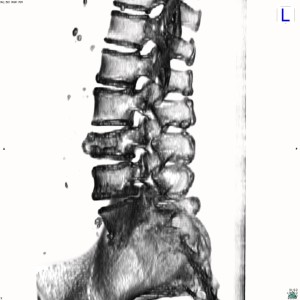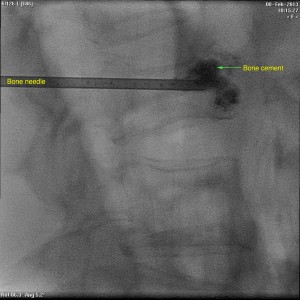VERTEBROPLASTY FOR OSTEOPOROTIC SPINAL FRACTURES

WHAT IS OSTEOPOROSIS?
The density of our bones secondary to the content of minerals in them. As we age, our bodies re-absorb calcium and other minerals from the bones which may potentially make them weaker. This may result in osteopenia (early signs of bone loss) and this can progress to osteoporosis (severe bone density loss).
Osteoporosis is a common condition, which affects over 1 million Australians. Usually, patients with osteoporosis have no symptoms until they suffer an osteoporotic fracture.
WHAT IS AN OSTEOPOROTIC FRACTURE?
A fracture is a broken bone. Patients with osteoporosis have fragile bones. Therefore they may fracture bones with minor falls or bumps. These bones include the wrist, the upper arm, ribs, hips or spine.
The block-shaped bones in the spine are called vertebra and support the weight of the body. Osteoporotic fractures in the spine are also called compression fractures as the vertebral bodies often lose height. Compression fractures in the spine can cause severe, debilitating pain. The pain may lead to reduced mobility and increased requirement of pain medications.
HOW CAN WE DIAGNOSE OSTEOPOROTIC SPINAL (VERTEBRAL) FRACTURES?

Often plain X-ray and CT scans may show a fracture as the vertebral body appears crushed or “wedged”. However, this does not tell us anything about the age of the fracture. Furthermore, some of these may fracture without any loss of vertebral body height.
An MRI is the examination of choice to diagnose an acute osteoporotic crush fracture. An MRI will show if there is any oedema in the vertebral body. The MRI will also reveal any fracture clefts.

WHAT IS VERTEBROPLASTY?
Vertebroplasty is a procedure in which medical cement is injected into an unhealed, fractured vertebral body. It is a procedure intended to alleviate pain in acute osteoporotic vertebral body fractures.
Fracture pain in osteoporotic compression fractures is due to the bony fragments moving and rubbing together. After vertebroplasty, the bone cement stabilises the fractured vertebra and consolidates the fracture fragments. This reduces fracture motion to eliminate the fracture pain and secondarily, this also helps to prevent further collapse of the treated vertebra.
WHY PERFORM VERTEBROPLASTY?
Most patients with osteoporotic compression fractures will have healed bones and pain relief in 10-12 weeks. However, there is a subset of patients who have severe, debilitating back pain. This pain leads to immobility and de-conditioning. The patient then will have a higher risk of lung compromise, pneumonia, cardiovascular compromise, clots forming in leg veins, lack of sleep and depression.
Increasing requirements for pain medication may also be problematic, leading to altered mental function and constipation.
In this group of patients with an acute fracture and debilitating pain, vertebroplasty is an effective tool to reduce the fracture pain and to restore the person’s mobility.
HOW IS VERTEBROPLASTY PERFORMED?

The patient is placed on a table in a specialised angiography suite (high quality x-rays). After local anaesthetic administration, needles are placed under x-ray guidance into the fractured vertebral body. The bone cement is then carefully injected under x-ray guidance, which ensures the correct placement and volume of cement in order to solidify and consolidate the fractured vertebral body. The bone cement hardens after several minutes.

Vertebroplasty is a “day-only” procedure. Sedation may be administered during the procedure. After a brief period of observation, the patient may be discharged home.
Links:
http://www.sirweb.org/patients/vertebroplasty-osteoporosis
http://www.cirse.org/index.php?pid=98

